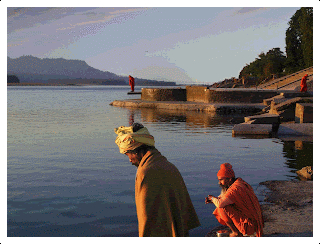On November 13th 2009 we headed towards the ancient city of Hastinapur located on the earlier course of the holy river Ganga. Hastinapur is mentioned in the great Hindu epic The Mahabharataan as it was the capital city of the kingdom of the Kauravas.
In the present day Hastinapura, which was re-established by Jawahrlal Nehru (first Prime Minister of India) in 1949, is a small town around 110 km from Delhi.
In the present day Hastinapura, which was re-established by Jawahrlal Nehru (first Prime Minister of India) in 1949, is a small town around 110 km from Delhi.
Now the Ganga flows in Makdumpur another 5-6 km from Hastinapur. We reached Makdumpur in another 10 or so minutes driving through beautiful farmlands and tiny villages. We drove all the way to the banks of the Ganga where we met some villagers. Ganga looked very dry with its bed visible almost every where and it flowed more like a small river.
Most surprising was to know from the villagers that the Ganga we were seeing was never here earlier and that it had changed its course by several kilometers. [I came to know later that Ganga has a tendency to change its course very often]. The river has done so in just last 10 or so years, according to the villagers. The changed course has taken over the land that belonged to the farmers. The villagers we talked to told us that the river still is eroding away the land of the farmers in the area. Farmers with the help of some nearby sugar mills are trying to stop the further erosion by building wooden barricades [See Picture] to slow down the flow of Ganga waters along the edges. The efforts are however proving futile with the river rising during the monsoons and taking away the barricades.
Farmers were using a boat to ferry their equipments including tractors across the Ganga to go to their farm lands, that have risen back as Ganga waters have subsided due to winters. I intended to see the land but it was quite late in the evening and decided to come back later after the 24th when, according to the villagers, the temporary bridge would be ready for our vehicle to cross the Ganga. [I called around 28th of Nov to see if the bridge was ready, but it wasn't and I had to drop my idea to visit Makdumpur again in this trip].
The pollution aspect of the river has begun... and my next stop would be the city of Kanpur... in-famous for polluting the Ganga.

Wonderful pictures Rahul bhai.
ReplyDeleteWhile reading your blog i felt as if was right there...watching this all by myself....You explained everything so beautifully....
You made me think that Ganga has given us sooo much but what are we giving in return??? Using it as a natural sewage?? Most of us dont even care about this.....But your blog made me feel that its the time to Change....To change ourselves..to Change our damn attitude towards Nature....Its Time to bring the Nature back to it's original Pure self.....
Commendable Work...looking forward to your next posts!!